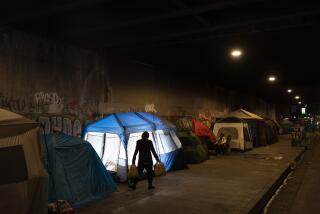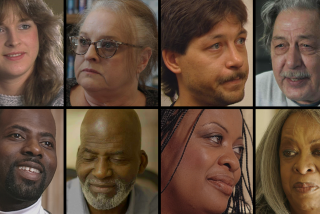Black Family Crisis Is America’s Crisis
- Share via
The statistics are now familiar to every informed observer of the American social scene. The images have been projected into our living rooms via nationally televised documentaries and investigative reports. Major newspapers in Los Angeles, Chicago, Washington and elsewhere have run serialized accounts of the tragedy unfolding in our midst. America has rediscovered the crisis of the black family.
I say re discovered because much of what is now being said and written had been anticipated more than two decades ago in the Moynihan Report. In 1965 Daniel Patrick Moynihan, now the Democratic senator from New York, was an assistant secretary in President Lyndon B. Johnson’s Labor Department. Fearing that the potential for the newly passed civil-rights legislation to produce full racial equality would be undermined by a trend toward female-headed families and out-of-wedlock births among blacks, Moynihan called for a national policy aimed at strengthening the black family. For his trouble he was denounced, by blacks and whites alike, as a racist “victim blamer” who sought only to divert attention away from the “real” issues--namely continuing white racism, and the unmet need for the infusion of billions into the social welfare budget.
Twenty years later the problem has grown much worse. The argument today is over whether or not the poor were actually made worse-off by Johnson’s “Great Society” programs.
Meanwhile, the fraction of black families headed by women has doubled from the approximately one-quarter which so alarmed Moynihan in 1965 to greater than one-half today. Nearly 60% of black children are born to unwed mothers, often to teen-age schoolgirls. Two-thirds of the children in black, female-headed households live in poverty.
So, we are now sounding an alarm--belatedly. One reason for this is surely the fact that teen-age pregnancy and unwed motherhood have reached alarming proportions among whites as well. Indeed, the rate of growth of these problems has been greater among whites than blacks in recent years. A study by Planned Parenthood last year found teen-age pregnancy to be twice as prevalent in the United States as in the Western European nations. Other research has discovered a rapid increase since 1970 in the proportion of American teen-agers who are sexually active.
Between 1970 and 1980 the rate of childbearing fell for every demographic category of women, black and white, young and old, married and single--except for unmarried white teen-agers, among whom the number of births per thousand women grew by 47%. Changes in sexual mores, the easy availability of abortion and contraceptives, the pervasive use of sex to sell products or provide “entertainment”--all of these have encouraged an erosion of traditional values and attitudes about adolescent sexuality. It is hardly surprising that poor blacks have been most dramatically affected by these society-wide trends.
But it is undeniable that something quite distinct and disturbing is happening in the inner city. Whereas the effects of rising family disruption among whites seem still manageable, the social decay occurring among poor blacks threatens the very possibility of achieving racial equality in our society. The weakness of poor black families combines with other problems--poor academic performance, violent criminal behavior, chronic joblessness--to create a seamless web of despair.
The result is threatening to the domestic peace of our nation. For not only do these communities constitute a breeding ground of social pathology with attendant costs for those of us comfortably ensconced in suburbia. They also stand as a stark reminder of the incompleteness of the civil-rights revolution. They make it impossible for us to finally lay to rest the great burden of race, which has haunted this country from its inception.
Though social science research does not support the claim that “welfare has caused the problem,” the data (and common sense) plainly indicate that the “no strings attached” availability of public assistance has made it possible for young black men and women to behave in ways ultimately destructive of their prospects for advancement. Overhaul of the system of income support for poor families, possibly with work requirements and more involvement of churches and community-based institutions in its administration, warrants exploration.
Moreover, while the lack of jobs for young inner-city men is an obstacle to the formation of stable families, the record of past employment-promoting schemes does not inspire confidence that we know how to convert unskilled, unlettered and often uninterested young men into productive workers. We must resist the temptation of simplistic nostrums, such as the idea that the lack of jobs is the root source of all social ills. Often youth unemployment and family instability stem from the common cause of failures of personal efficacy and motivation among ghetto teens.
Finally, we must try to move beyond the exchange of epithets and accusations. This problem is in no direct way the result of “white racism”; neither does it reflect genetic inferiority of blacks. It arises from a past in which racism has played a role, but in which there has been sufficient failure among blacks for us to shoulder a sizeable share of responsibility as well. This crisis of inner-city America, though rooted in our history of race relations and continuing to cast a cloud over the dream that we may one day become a colorblind society, reflects a human tragedy that transcends racial boundaries. It challenges all of us, in the words of Martin Luther King Jr., to “rise up from (our) stool of indifference, to retreat from (our) flight into unreality, and to bring (our) full resources--(our) heart(s), (our) mind(s) and (our) checkbook(s)--to the aid of the less fortunate brother.”
More to Read
Sign up for Essential California
The most important California stories and recommendations in your inbox every morning.
You may occasionally receive promotional content from the Los Angeles Times.













